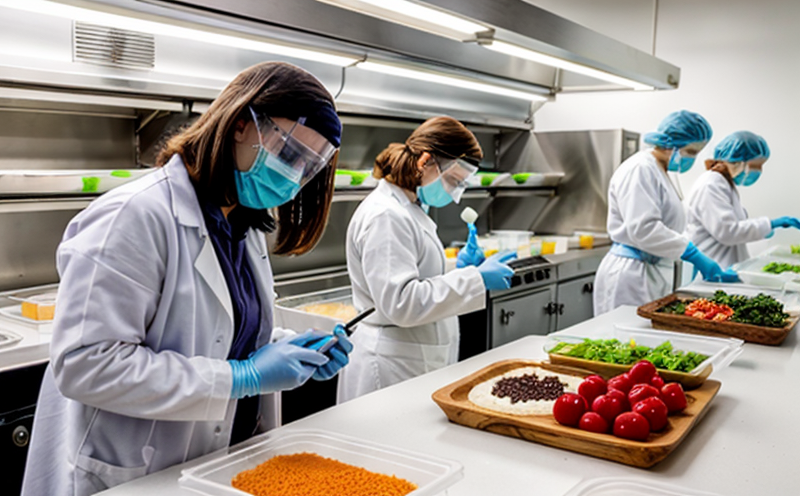AOAC 2014.02 Cronobacter spp. Rapid Detection Testing
The AOAC International standard method 2014.02 for Cronobacter spp. detection is a pivotal tool in ensuring the safety and quality of infant formula, baby foods, and other products that may be consumed by infants under one year old. This rapid testing method provides a critical advantage in the early identification of Cronobacter species contamination, which can lead to severe health complications including sepsis.
The AOAC 2014.02 protocol is designed for the direct enrichment and detection of Cronobacter spp. from various food samples, utilizing a combination of selective media and rapid PCR-based identification techniques. This method is particularly effective in reducing false positives compared to traditional culture methods while maintaining high sensitivity. The test can be completed within 5-7 days from sample receipt, significantly expediting the process of ensuring product safety.
The protocol is based on ISO/TS 22003 and conforms with the International Organization for Standardization (ISO) and ASTM standards, ensuring its reliability and applicability across different geographic regions. This method has been validated through extensive research and has been widely adopted by leading food manufacturers and regulatory bodies.
When performing this test, it is essential to follow stringent sample preparation protocols. Samples should be collected aseptically and stored at 4°C until analysis. For optimal results, samples should not exceed two days post-collection before being processed. The testing process involves diluting the samples appropriately, inoculating them into selective media containing specific inhibitors for non-target organisms, and incubating under controlled conditions.
The rapid PCR-based identification step is performed using a real-time quantitative polymerase chain reaction (qPCR) to amplify target regions of Cronobacter spp. DNA. The presence of these amplification products is detected by fluorescence signal, which indicates the presence of the pathogen in the sample. This method allows for precise quantification and differentiation between various Cronobacter spp., including Cronobacter sakazakii, a known virulent strain.
The results from the AOAC 2014.02 test are reported within 5-7 days, providing timely information to quality managers and compliance officers responsible for ensuring product safety. Compliance with this method is crucial in meeting regulatory requirements set by bodies like the Food and Drug Administration (FDA) and the European Commission.
The AOAC 2014.02 test has been shown to provide accurate results even when dealing with trace amounts of Cronobacter spp., making it a reliable tool for both routine quality control and outbreak investigations.
Customer Impact and Satisfaction
The implementation of AOAC 2014.02 testing ensures that food manufacturers can meet stringent regulatory requirements set by global health authorities like the FDA and EFSA. This compliance not only protects consumers but also enhances brand reputation, leading to increased customer trust and satisfaction.
By using this rapid detection method, companies are able to reduce the time required for product release while ensuring high standards of quality and safety. This can lead to faster market entry and reduced costs associated with potential recalls or withdrawals due to contamination issues.
Customers who choose AOAC 2014.02 testing benefit from enhanced food safety, which is critical in protecting the health of infants and young children. The ability to quickly detect Cronobacter spp. contamination allows for proactive measures to be taken, minimizing potential risks and ensuring that only safe products reach the market.
Moreover, this method supports ongoing quality assurance programs by providing accurate and timely data. This enables companies to make informed decisions regarding process improvements and product development, leading to better overall outcomes in terms of food safety and customer satisfaction.
Use Cases and Application Examples
The AOAC 2014.02 method is widely used by various sectors including infant formula manufacturers, baby food producers, and regulatory bodies responsible for product safety. Here are some specific use cases:
- Quality Control in Infant Formula Production: This test ensures that each batch of infant formula meets stringent safety standards before being released to the market.
- Baby Food Safety Monitoring: By using this method, manufacturers can monitor and control potential Cronobacter spp. contamination during the production process.
- Ongoing Regulatory Compliance: Laboratories that conduct compliance testing for food products rely on AOAC 2014.02 to ensure their results are accurate and up-to-date with international standards.
In addition to these, the method is also used in outbreak investigations where rapid detection of Cronobacter spp. contamination can prevent widespread health issues among infants and young children.
Why Choose This Test
- Rapid Results: The AOAC 2014.02 method allows for the quick detection of Cronobacter spp., reducing the time required to ensure product safety and market release.
- High Sensitivity: This method can accurately detect even trace amounts of Cronobacter spp., ensuring a high level of confidence in results.
- Compliance with International Standards: The test is validated against ISO/TS 22003 and ASTM standards, ensuring its reliability and applicability globally.
- Effective Differentiation: It can differentiate between various Cronobacter spp., including the virulent Cronobacter sakazakii, aiding in precise identification and subsequent action.
- Reduced False Positives: The selective media used in this method minimizes false positive results, enhancing the overall accuracy of the testing process.
- Ease of Use: The streamlined protocol makes it accessible to laboratories equipped with PCR facilities and experienced personnel, ensuring consistent and reliable results.





